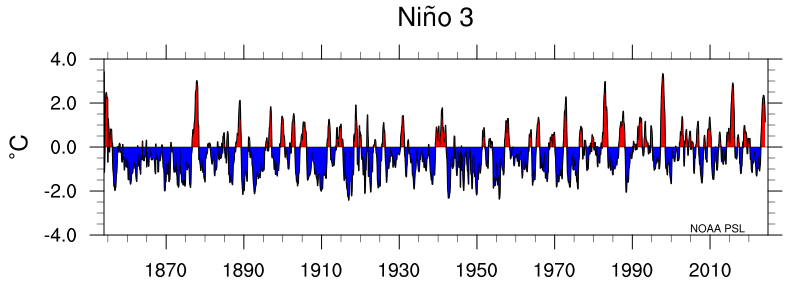La Niña Index Dashboard
ENSO is an phenomena which extends over large spatial area and can have a different seasonal evolution from event to event. The different patterns have implications for climate impacts both locally and at a distance. The following indices all help characterize ENSO but at different locations and time scales. See the PSL news story on flavors of ENSO. Also see the web page to analyze and compare time series. There are two products available. First are plots of the progression of the latest data compared to historic La Niña events. There is a shorter time-series (1948 onward) index section and a longer (1870 onward) one. There are less time series that cover from 1870 to present. Second are time-series plots of various ENSO indices.
There is also a El Niño Dashboard looking at the current time-series values and comparing them to historic El Niño events.
| These plots show the 2021-22 values compared to various indices for seven La Niña events since 1948. | ||||
| Name | Description | Current Value vs. Historic La Niña Events |
Latest Value | Date |
|---|---|---|---|---|
MEI V2 |
A multi-variate index of ENSO which uses SST, winds, SLP, and OLR. It is calculated using the JRA55 reanalysis dataset and the NCEI OLR. Produced at NOAA PSL. | 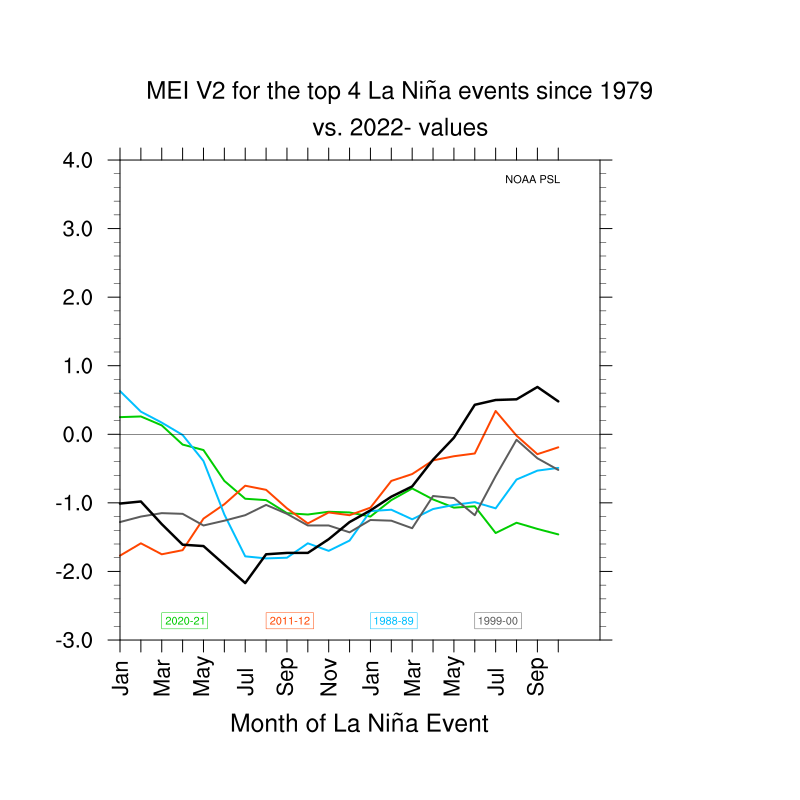 |
-0.77 | Dec 2025 |
Niño 4 |
SST anomalies averaged over the NINO4 region 5°North-5°South; 160°East-150°West (western most of Niño indices; see map of ENSO regions). Total SSTs also available for this region. Calculated from the Monthly NOAA ERSST V5 (at NOAA/CPC). | 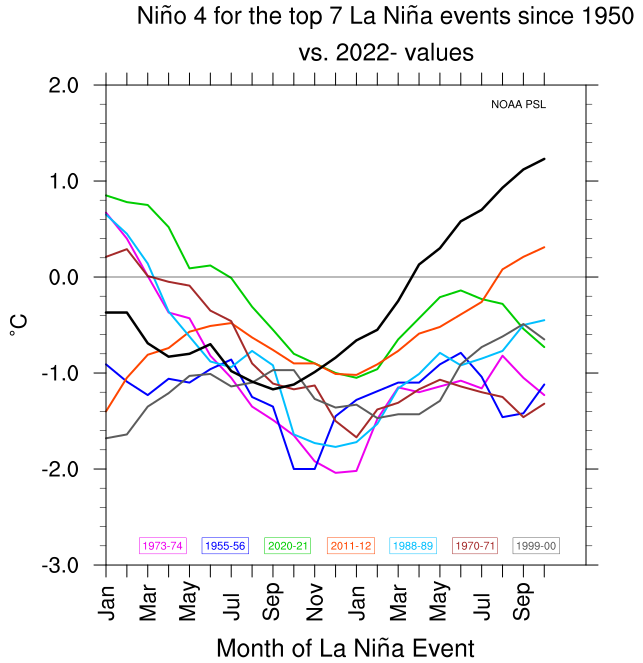 |
-0.36 | Dec 2025 |
Niño 3.4 |
SST anomalies averaged over the NINO34 region 5°North-5°South;170-120°West; see map of ENSO regions). Total SSTs also available for this region. Correlates well with teleconnections to North America. Calculated from the Monthly NOAA ERSST V5 (at NOAA/CPC). | 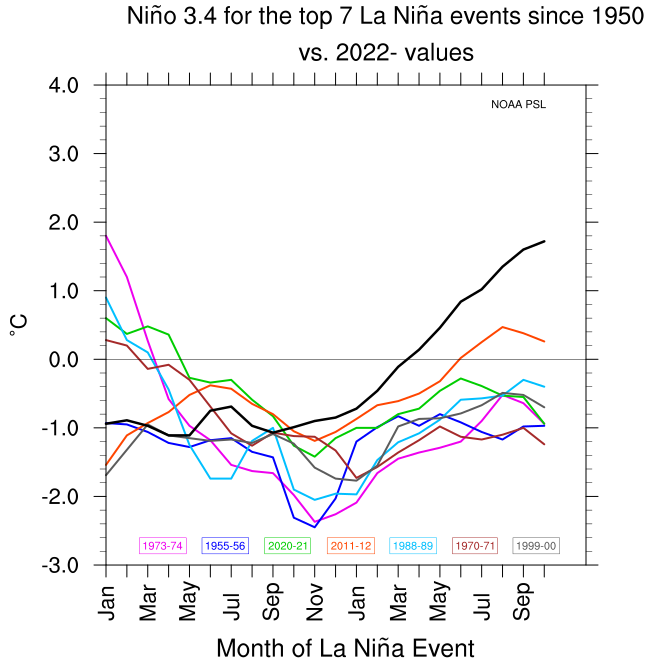 |
-0.66 | Dec 2025 |
Niño 3 |
SST anomalies averaged over the NINO3 region 5°North-5°South;150°West-90°West; see map of ENSO regions). Total SSTs also available for this region. Calculated from the Monthly NOAA ERSST V5 (at NOAA/CPC). |  |
-0.78 | Dec 2025 |
Niño 1.2 |
SST anomalies averaged over the NINO1 and NINO2 regions 0-10°South;90°West-80°West (eastern most of the Niña indices; see map of ENSO regions). Total SSTs also available for this region. Calculated from the Monthly ERSST V5 (at NOAA/CPC). | 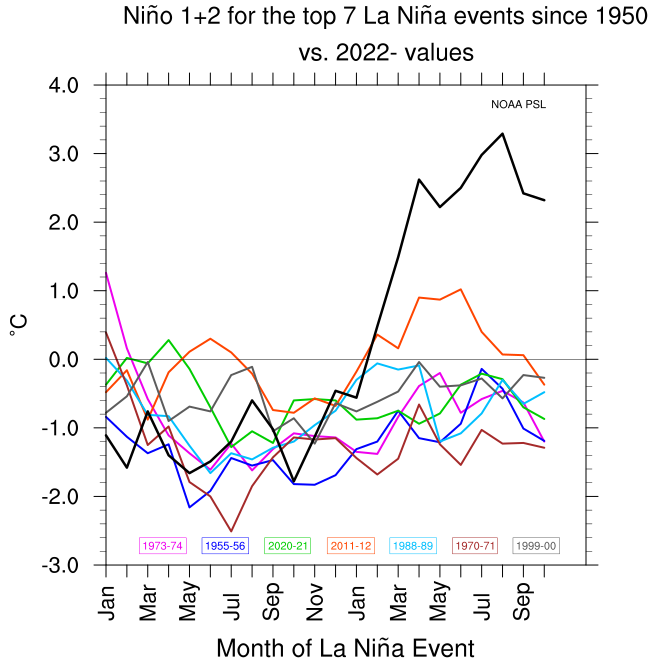 |
-0.71 | Dec 2025 |
ONI |
Oceanic Niño Index: 3 month running mean of ERSST.v5 SST anomalies in the Niño 3.4 region (5°N-5°S, 120°-170°W) Calculated from the ERSST V5 (at NOAA/CPC). | 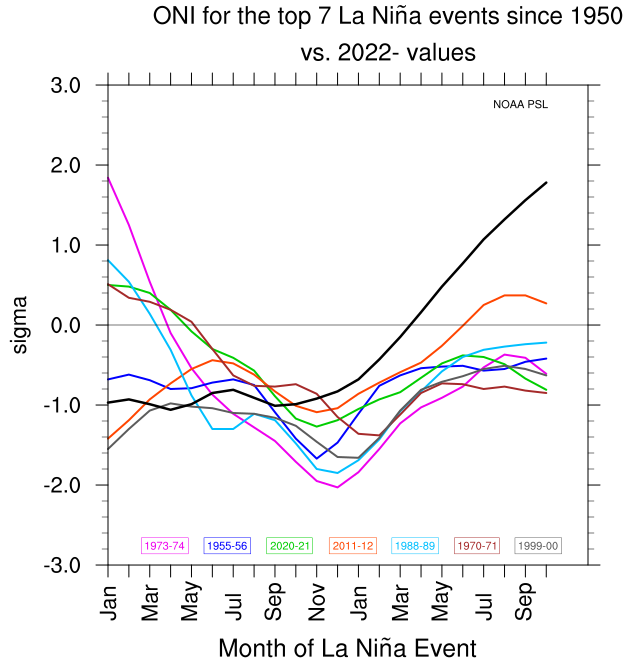 |
-0.45 | Sep 2025 |
BEST |
Bivariate El Nino- Southern Oscillation Index: The Niño 3.4 SST and SOI are normalized and combined. SST is from the HadISST1.1. SOI is from NOAA/CPC. Produced at NOAA PSL. | 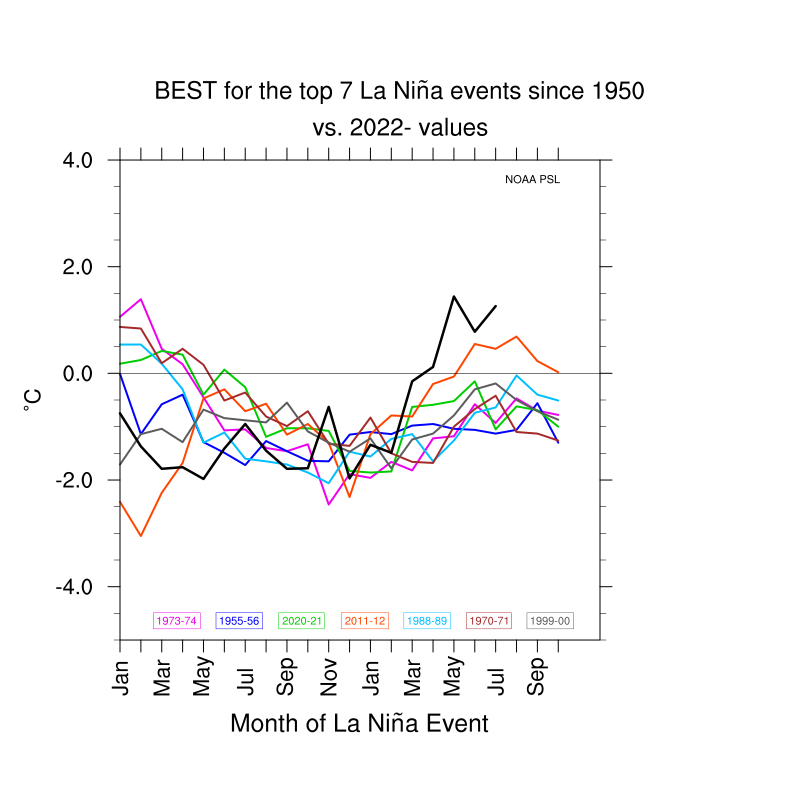 |
-0.38 | Aug 2025 |
SOI |
Southern Oscillation Index: Difference between standardized Darwin and standardized Tahiti surface pressure values. It represents the atmospheric component of the ENSO. The sign is opposite that of the Nino indices and it is noisier than those indices. From NOAA/CPC | 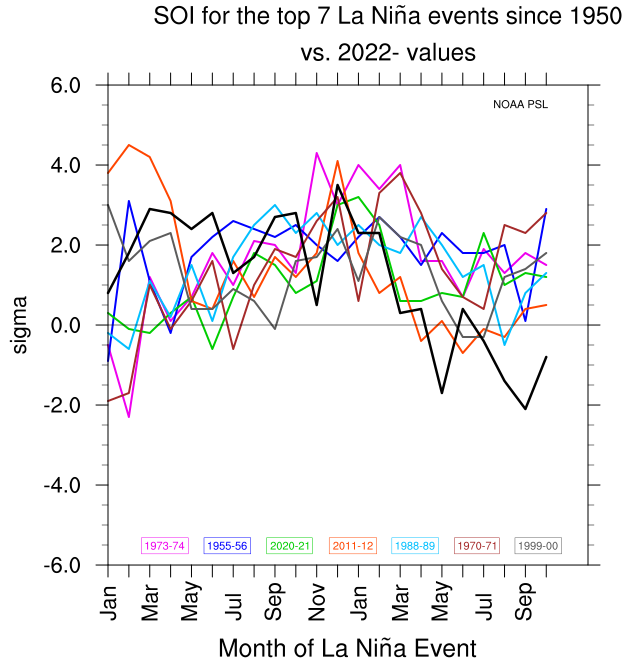 |
-0.00 | Dec 2025 |
TNI |
Trans-Niño Index: Standardized Niño 1+2 minus the Niño 4 with a 5 month running mean applied (restandardized). It represents the gradient of the SST in the ENSO region of the tropical Pacific. Calculated from the Monthly HadISST1.1 dataset. | 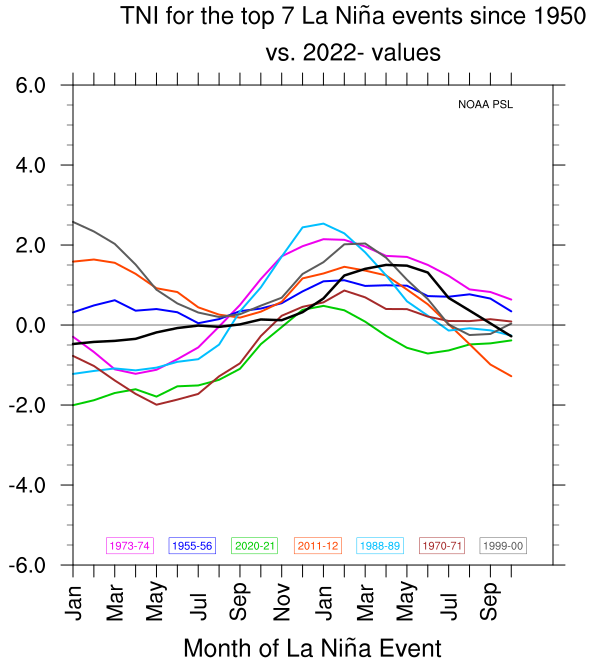 |
-0.31 | Jun 2025 |
PDO |
Pacific Decadal Oscillation: leading principal component of monthly SST anomalies in the North Pacific Ocean, poleward of 20N (global SST mean removed). Calculated from the NOAA OISST V1 and V2 (U of Washington). | 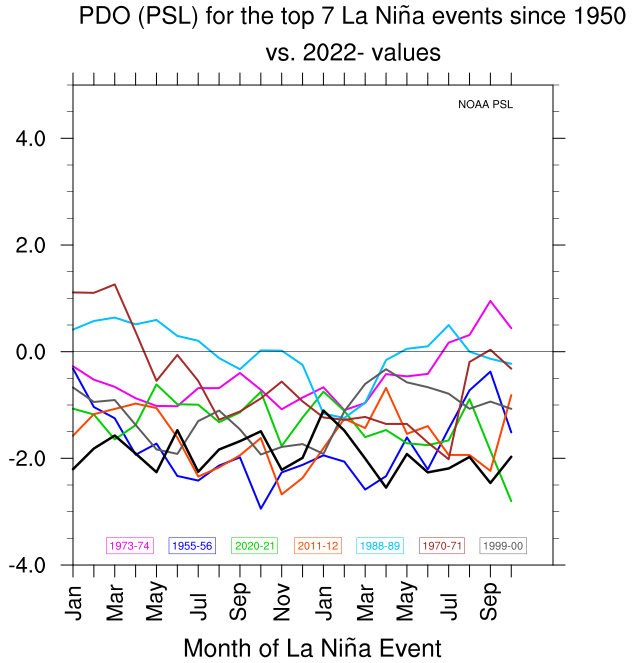 |
-2.81 | Aug 2025 |
PNA |
Pacific NorthAmerican Pattern. The PNA is one of the most prominent modes of extratropical variability in the northern Hemisphere. This version is calculated at NOAA/CPC. It is based on EOF's calculated from monthly anomalies of 500mb height from the NCEP Reanalysis. | 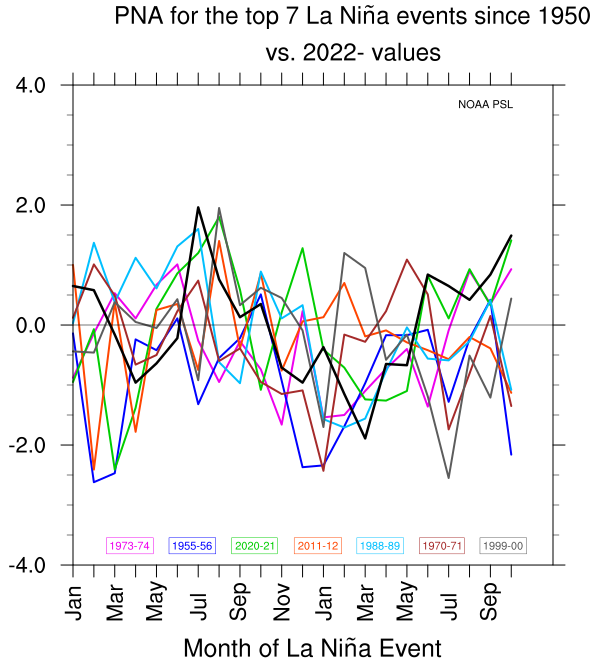 |
-1.71 | Dec 2025 |
OLR | Outgoing Longwave Radiation (OLR) area averages over the central equatorial Pacific (160°E-160°W). OLR is a good measure of convection. Negative OLR represents increased convention. Calculated at NOAA/CPC. |  |
1.10 | Dec 2025 |
Heat Content |
Tropical Pacific integrated temperature anomalies (0-300m) 160°E–80°W. Calculated at NOAA/CPC from the GODAS dataset. |  |
0.01 | Dec 2025 |
850mb Zonal Winds |
850mb zonal wind anomalies averaged over the western tropical Pacific (140E-170W). From NOAA/PSL using the NCEP/NCAR Reanalysis |  |
-2.82 | Dec 2025 |
200mb Zonal Winds |
200mb Zonal Wind anomalies 2.5S-2.5N; 165W-110W. Calculated at NOAA/PSL from the NCEP/NCAR Reanalysis. | 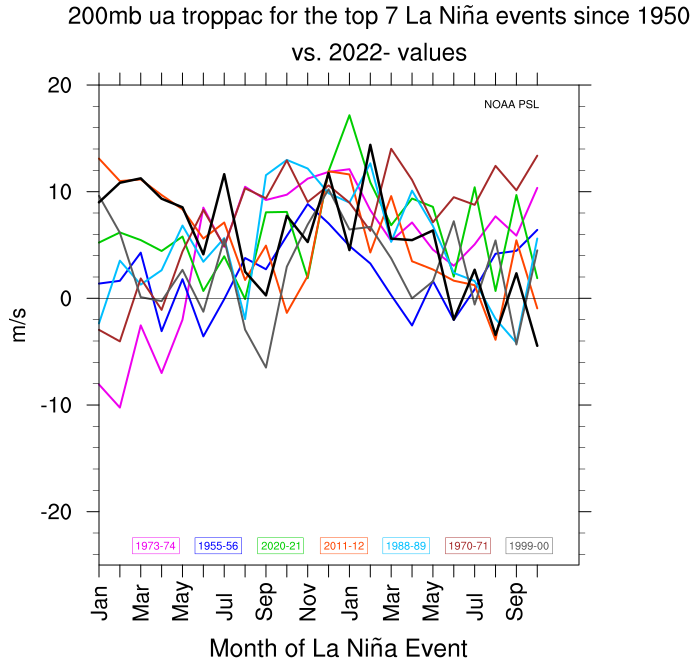 |
4.57 | Dec 2025 |
ESPI Precip Index |
ENSO Precipitation Index. The index is based on rainfall anomalies in two rectangular areas, one in the eastern tropical Pacific (10°S-10°N, 160°E-100°W) and the other over the Maritime Continent (10°S-10°N, 90°E-150°E). The first step of the procedure involves moving a 10° by 50° block around each box; the minimum and maximum values of all possible blocks is obtained for each box and these are combined to estimate an El Niño precipitation index (EI) and a La Niña precipitation index (LI). The EI and LI are in turn combined to create the ESPI index. Finally, the ESPI index is normalized to have zero mean and unit standard deviation. Calculated at UMD. | 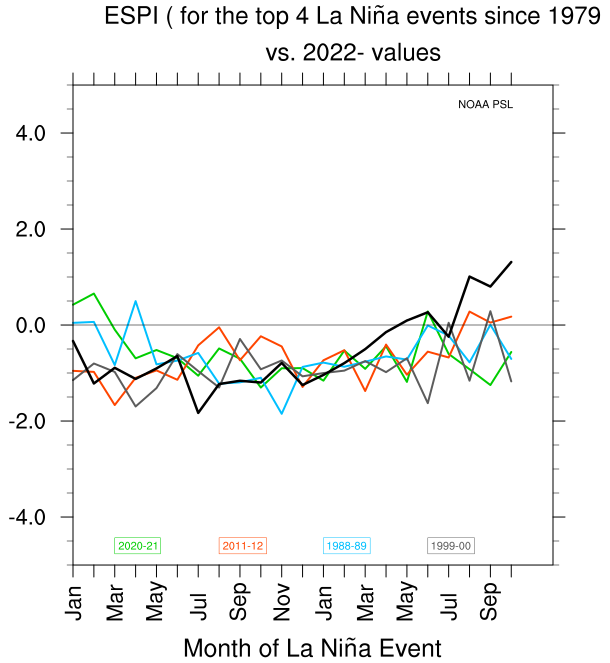 |
1.31 | Oct 2023 |
| These plots show the current event values of various indices vs 9 events since 1870. | ||||
| Name | Description | Current value vs Historic La Niiño Events | Latest Value | Date |
|---|---|---|---|---|
Niño 4 |
SST anomalies averaged over the NINO4 region 5°North-5°South; 160°East-150°West (western most of Niño indices). Total SSTs also available for this region. Calculated from the Monthly NOAA ERSST V5 (at NOAA PSL). Climatology 1981-2010. |  |
-0.25 | Dec 2025 |
Niño 3.4 |
SST anomalies averaged over the NINO34 region 5°North-5°South;170-120°West. Total SSTs also available for this region. Correlates well with teleconnections to North America. Calculated from the Monthly NOAA ERSST V5 (at NOAA PSL). Climatology 1981-2010. |  |
-0.51 | Dec 2025 |
Niño 3 |
SST anomalies averaged over the NINO3 region 5°North-5°South;150°West-90°West. Total SSTs also available for this region. Calculated from the Monthly NOAA ERSST V5 (at NOAA PSL). Climatology 1981-2010. | 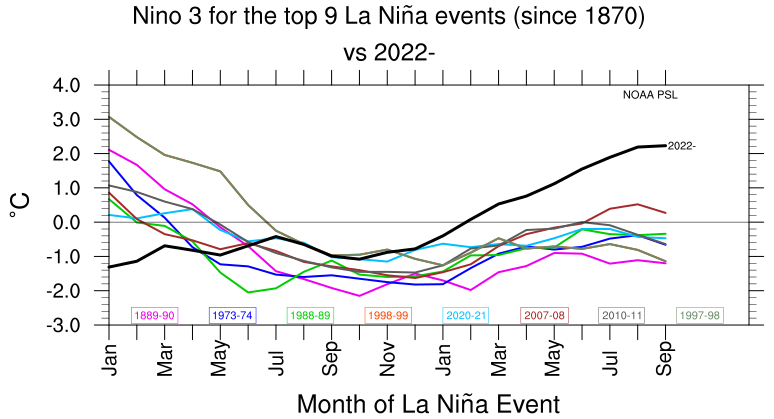 |
-0.75 | Dec 2025 |
Niño 1.2 |
SST anomalies averaged over the NINO1 and NINO2 regions 0-10°South;90°West-80°West (eastern most of the Niña indices). Total SSTs also available for this region. Calculated from the Monthly NOAA ERSST V5 (at NOAA PSL). Climatology 1981-2010. | 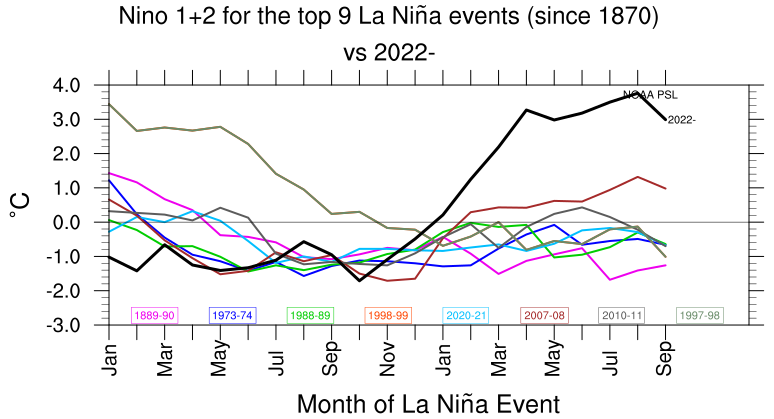 |
-0.73 | Dec 2025 |
TNI |
Trans-Niño Index: Standardized Niño 1+2 minus the Niño 4 with a 5 month running mean applied (restandardized). It represents the gradient of the SST in the ENSO region of the tropical Pacific. Calculated from the Monthly HadISSTV1.1 dataset. | 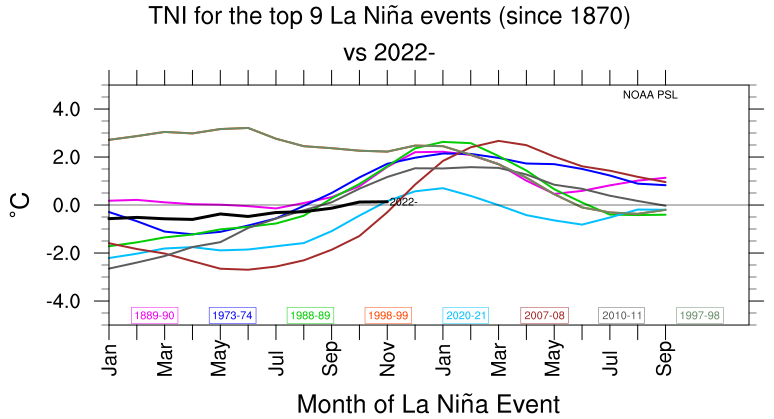 |
-0.31 | Jun 2025 |
| These plots show time-series plots of the monthly values from 1948 to present for the set of ENSO indices. | ||||||
| Name | Description | Time Series | Latest Value | Units | Latest date | Get Values |
|---|---|---|---|---|---|---|
MEI V2 |
A multi-variate index of ENSO which uses SST, winds, SLP, and OLR. It is calculated using the JRA55 reanalysis dataset and the NCEI OLR. Produced at NOAA PSL. |  |
-0.77 | sigma | Dec 2025 | Get |
Niño 4 | SST anomalies averaged over the NINO4 region 5°North–5°South; 160°East–150°West (western most of Nino indices). Total SSTs also available for this region. Calculated from the Monthly ERSST V5 (at NOAA/CPC). | 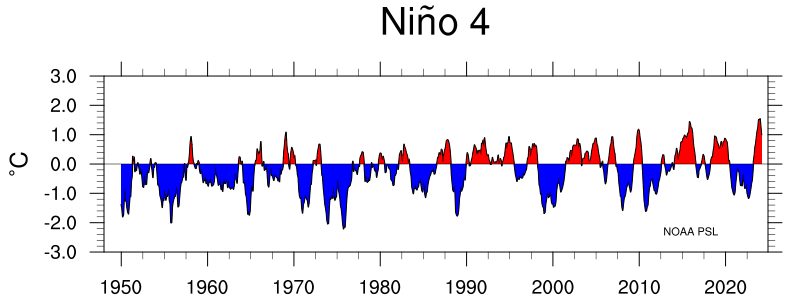 |
-0.36 | °C | Dec 2025 | Get |
Niño 3.4 | SST anomalies averaged over the NINO34 region 5°North-5°South;170-120°West. Total SSTs also available for this region. Correlates well with teleconnections to North America. Calculated from the Monthly ERSST V5 (at NOAA/CPC). | 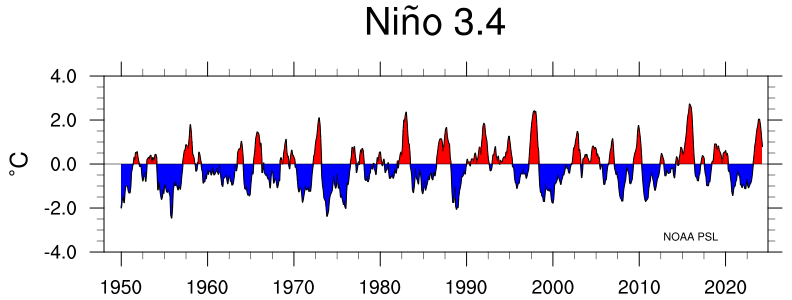 |
-0.66 | °C | Dec 2025 | Get |
Niño 3 |
SST anomalies averaged over the NINO3 region 5°North–5°South; 150°West–90°West. Total SSTs also available for this region. Calculated from the Monthly ERSST V5 (at NOAA/CPC). | 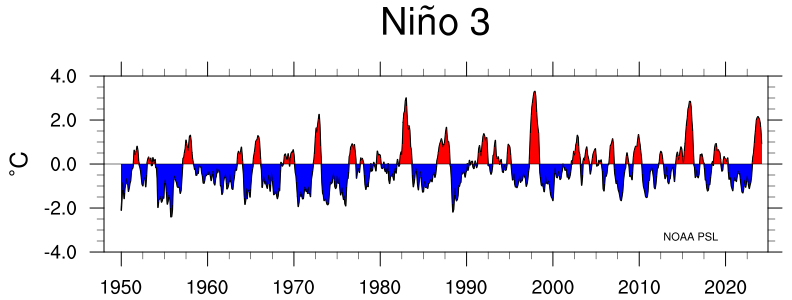 |
-0.78 | °C | Dec 2025 | Get |
Niño 1+2 | SST anomalies averaged over the NINO1 and NINO2 regions 0-10°South; 90°West–80°West (eastern most of the Niña indices). Total SSTs also available for this region. Calculated from the Monthly ERSST V5 (at NOAA/CPC). | 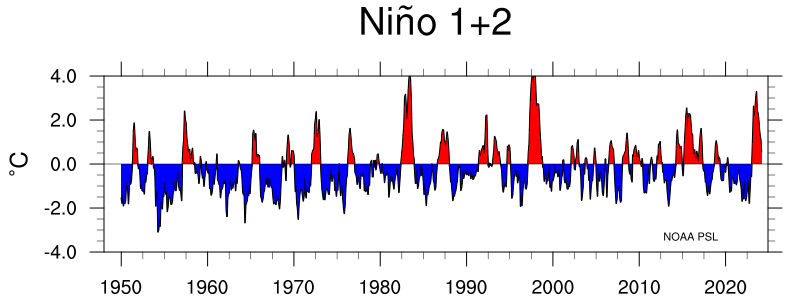 |
-0.71 | °C | Dec 2025 | Get |
ONI | Oceanic Niño Index: 3 month running mean of ERSST.v4 SST anomalies in the Niño 3.4 region (5°N–5°S, 120°&8211;170°W) Calculated from the ERSST V5 (at NOAA/CPC). |  |
-0.45 | °C | Sep 2025 | Get |
BEST | Bivariate El Nino- Southern Oscillation Index: The Niño 3.4 SST and SOI are normalized and combined. SST is from the HadISST1.1 SOI is from NOAA/CPC. Produced at NOAA PSL. |  |
-0.38 | diff std | Aug 2025 | Get |
SOI | Southern Oscillation Index: Difference between standardized Darwin and standardized Tahiti surface pressure values. It represents the atmospheric component of the ENSO. The sign is opposite that of the Nino indices and it is noisier than those indices. From NOAA/CPC |  |
-0.00 | diff std | Dec 2025 | Get |
TNI | Trans-Niño Index: Standardized Niño 1+2 minus the Niño 4 with a 5 month running mean applied (restandardized). It represents the gradient of the SST in the ENSO region of the tropical Pacific. Calculated from the Monthly HadISST1.1 dataset. |  |
-0.31 | sigma | Jun 2025 | Get |
PDO | Pacific Decadal Oscillation: leading principal component of monthly SST anomalies in the North Pacific Ocean, poleward of 20N (global SST mean removed). Calculated from the NOAA OISST V1 and V2 (U of Washington). | 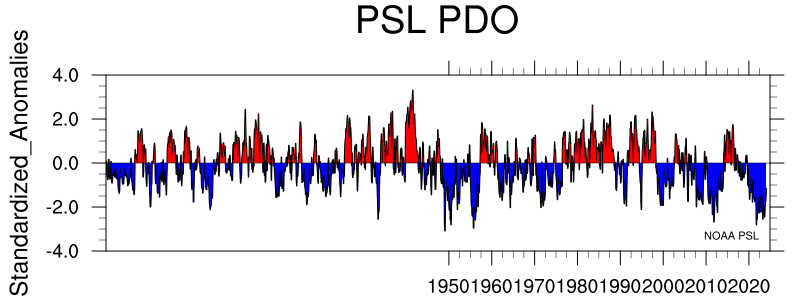 |
-2.81 | sigma | Aug 2025 | Get |
PNA | Pacific NorthAmerican Pattern. The PNA is one of the most prominent modes of extratropical variability in the northern Hemisphere. This version is calculated at NOAA/CPC. It is based on EOF's calculated from monthly anomalies of 500mb height from the NCEP Reanalysis. |  |
-1.71 | sigma | Dec 2025 | Get |
OLR | Outgoing Longwave Radiation (OLR) area averages over the central equatorial Pacific (160°E–160°W). OLR is a good measure of convection. Negative OLR represents increased convention. Calculated at NOAA/CPC. | 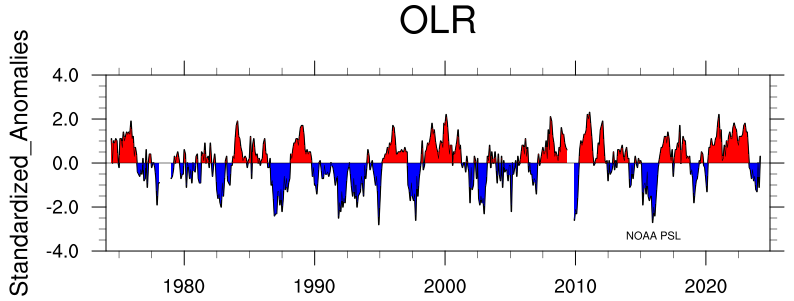 |
1.10 | sigma | Dec 2025 | Get |
Heat Content | Tropical Pacific integrated temperature anomalies (0-300m) 160°E-–0°W. Calculated at NOAA/CPC from the GODAS dataset. | 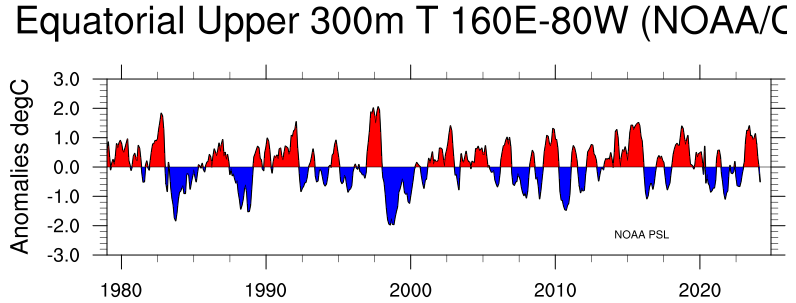 |
0.01 | °C | Dec 2025 | Get |
200mb U | 200mb Zonal Wind anomalies (2.5°S–2.5°N; 165°W–110°W). Calculated at NOAA PSL from the NCEP R1 dataset. | 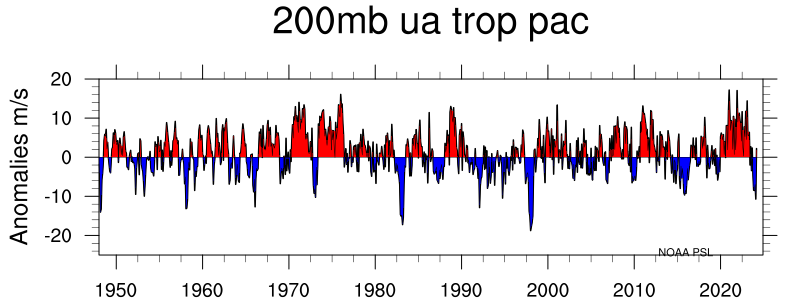 |
4.57 | °C | Dec 2025 | Get |
ESPI Precip Index |
ENSO Precipitation Index. The index is based on rainfall anomalies in two rectangular areas, one in the eastern tropical Pacific (10°S-10°N, 160°E-100°W) and the other over the Maritime Continent (10°S-10°N, 90°E-150°E). The first step of the procedure involves moving a 10° by 50° block around each box; the minimum and maximum values of all possible blocks is obtained for each box and these are combined to estimate an El Niño precipitation index (EI) and a La Niña precipitation index (LI). The EI and LI are in turn combined to create the ESPI index. Finally, the ESPI index is normalized to have zero mean and unit standard deviation. Calculated at UMD. |  |
1.31 | SIGMA | Oct 2023 | Get |
| These plots show time-series plots of the monthly values from 1870 to present for the set of ENSO indices. | ||||||
| Name | Description | Time Series | Latest Value | Units | Latest date | Get Values |
|---|---|---|---|---|---|---|
Niño 4 |
SST anomalies averaged over the NINO4 region 5°North-5°South; 160°East-150°West (western most of Nino indices). Total SSTs also available for this region. Calculated from the Monthly ERSST V5 (at NOAA PSL). |  |
-0.25 | sigma | Dec 2025 | Get |
Niño 3.4 |
SST anomalies averaged over the NINO34 region 5°North-5°South;170-120°West. Total SSTs also available for this region. Correlates well with teleconnections to North America. Calculated from the Monthly NOAA ERSST V5 (at NOAA PSL). Climatology 1981-2010. | 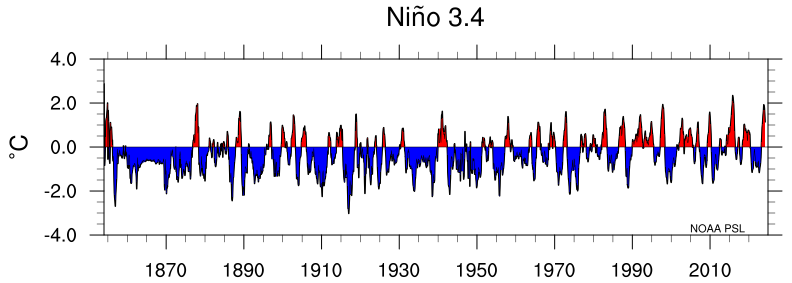 |
-0.51 | sigma | Dec 2025 | Get |
Niño 3 |
SST anomalies averaged over the NINO3 region 5°North-5°South;150°West-90°West. Total SSTs also available for this region. Calculated from the Monthly NOAA ERSST V5 (at NOAA PSL). Climatology 1981-2010. | -0.75 | sigma | Dec 2025 | Get | |
Niño 1+2 |
SST anomalies averaged over the NINO1 and NINO2 regions 0-10°South;90°West-80°West (eastern most of the Nina indices). Total SSTs also available for this region. Calculated from the Monthly NOAA ERSST V5 (at NOAA PSL). Climatology 1981-2010. |  |
-0.73 | sigma | Dec 2025 | Get |
TNI |
Trans-Niño Index: Standardized Niño 1+2 minus the Niño 4 with a 5 month running mean applied (restandardized). It represents the gradient of the SST in the ENSO region of the tropical Pacific. Calculated from the Monthly HadISSTV1.1 dataset. | 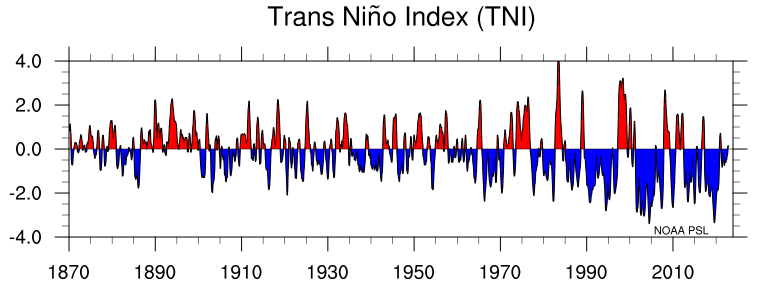 |
-0.31 | sigma | Jun 2025 | Get |
